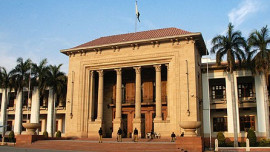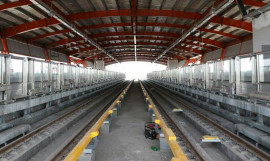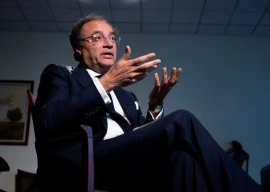
The development image of the provinces is becoming a major issue for the public discourse in the approaching general elections. Take deliberate political casting of types by adversaries or common perception, Punjab is known as a province building large infrastructure, roads, underpasses, overpasses, bypasses, power stations, metro bus systems, orange train and other means of mass transit.
Even social sector projects focus on constructing buildings of large hospitals and new universities. You name it and there is a company for it — clean drinking water, waste management. The concern is with the hardware of development and the objective, according to detractors, is to skim off the top of large contracts. Huge cuts are possible only in mega projects. As opposed to this, the image of K-P painted by its government and the ruling party concerns the software of development. The emphasis is on delivering services, changing the way education is imparted and health is accessed and delivered. There is talk of students returning from private to better-run public schools and more satisfied patients due to improved management practices in the existing public hospitals. It invests in the police and not thanas, and in ensuring justice for all. Instead of building new assets, the priority is to make the existing assets work to their potential. Better governance rather than larger development spending is the aim. In short, the emphasis in K-P is on human development.
The UNDP’s latest Pakistan National Human Development Report, however, tells a different story. Its human development rankings take the steam out of the engine of human development paraded by the tabdeeli band. All over Pakistan, there are only six districts ranked as high-human development districts. Four of these districts are in Punjab and none from K-P. The next category is high medium human-development districts. Four K-P districts make it, but against 19 districts from Punjab. No province of Pakistan earns the top ranking of high human development. Punjab is ranked one category below as a high medium human-development provinces. Even here the K-P province as a whole lies in the lower ranking of medium human development.
Two main components of human development are health and education. Punjab is leading in both. In health, the immunisation rate in Punjab is 89 per cent, higher than K-P’s 78 per cent. The satisfaction with health facilities in Punjab was measured at 78 per cent, again higher than 73 per cent in K-P. Education too is a disappointment for K-P. Expected years of schooling in Punjab are 10.1 compared to K-P’s 9.7. There is a big difference in mean years of schooling. K-P’s 3.3 years is well behind 4.6 years in Punjab.
Winning votes in the coming elections is a lot about wooing the youth bulge in our population. The UNDP report is themed around youth. It ranks regions by youth development. Youth Development Index puts K-P in the low achievers. Eastern Punjab and Northern Punjab with respective scores of 0.611 and 0.607 are placed in the category of high youth development. Central Punjab (0.563), Western Punjab (0.528) and Southeastern Punjab (0.518) are ranked as medium youth-development regions. Southeastern Punjab, routinely described as the lost region of Punjab and a source of recent political defections, is ranked medium youth-development region compared to low youth-development ranking of Southern K-P (0.423) and Central K-P (0.412). Northern K-P (0.380) is further down the line in the category of very low youth development. K-P is not only behind Punjab, it falls far behind even Southeastern Punjab.
Seemingly, economic and human development go hand in hand in Punjab.
Published in The Express Tribune, May 18th, 2018.
Like Opinion & Editorial on Facebook, follow @ETOpEd on Twitter to receive all updates on all our daily pieces.










































1713521455-0/Untitled-design-(9)1713521455-0-270x192.webp)















COMMENTS (2)
Comments are moderated and generally will be posted if they are on-topic and not abusive.
For more information, please see our Comments FAQ